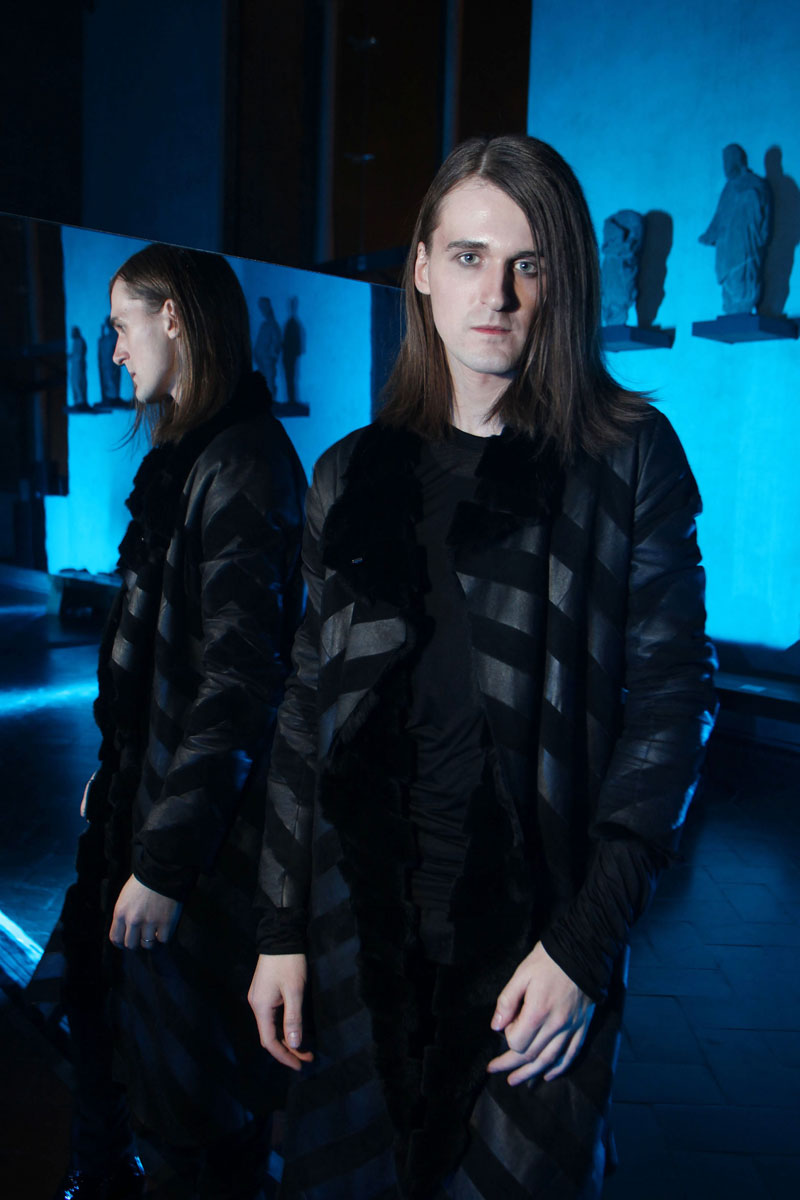Gareth Pugh at Pitti: On the Extreme

GARETH PUGH AT HIS PITTI UOMO SHOW. PHOTO COURTESY OF G. GAZIA/NONAMEPHOTO
Christmas is over, it’s raining, and everything is on sale—but the dreamier side of life is there, if you know where to look. Last Thursday night, the place to find it was in the double towers of the 14th century Orsanmichele church in Florence. The occasion was Gareth Pugh’s small collection show for Pitti, the Italian trade fair devoted to menswear, which includes a women’s annex for pre-collections, those early-bird designs that keep cash register ringing before the spring and winter merchandise arrives.
Despite the demands of today’s fashion business, Pugh remains happily untamed, as does his Paris backer Michele Lamy (who also manages Rick Owens, her partner in work and life). Together, they form an unruly troika, responsible for some of the most exciting and spontaneous ideas in clothes today. The Pitti organization is no slouch, either: each season it sponsors original shows in historic sites throughout Florence, from young designers like Adam Kimmel, Kris Van Assche and Raf Simons.
For Pugh, this invitation from Florence was an opportunity to show color, which he has rarely done since he began presenting his collections in 2005 in London. Now a fixture in Paris, where he shows his men’s and women’s collections together, Pugh is one of the first English designers, along with Christopher Kane, who is growing his eponymous business in London rather than designing full-time for a major European label.
I took the tall, thin gentleman walking a few paces in front of me, dressed in a coat of swirling strips of black leather and multi-buckle boots, for a Florentine eccentric before he turned around and I recognized the familiar face of Gareth Pugh. At 29, he is precariously juggling his maverick design sense with the fragile cash flow of a young business.
“For me, this is a big honor,” says Pugh. “The collection is a subtle hint to what I will show next March in Paris, and it’s based as usual on the juxtaposition of hard/soft, masculine/feminine and light/dark. I visited Florence last October and looked at Italian history going into art, architecture, and religious iconography, and it inspired me.”
Instead of doing a traditional runway show, Pugh decided to produce a 12-minute, fashion-show-length film, directed by frequent collaborator Ruth Hogben, whom he met when she was assisting the photographer Nick Knight. The two have been almost inseparable ever since, and it now appears that Hogben’s scenarios inspire Pugh to design. “It’s kind of like those beautiful Caravaggio paintings,” he says of the small collection he designed for the show in Florence. “There’s people coming out of blackness, halos over heads, sins and angels.”
Presented on two 22-meter-long rectangular ceiling screens hanging from the rafters in one of the Orsanmichele towers, Natasa Vojnovic, Jonathan Baker, and a few other dancers twisted and leapt over the audience like a pack of sexy gargoyles for Pugh’s fresco. Sequins flashed, balloon shapes blew up around all these beautiful bodies, and eventually everything got wet, but it was hard to get much of an idea about the actual clothes.
Luckily, Pitti had invited Pugh to display a few key pieces on dressmaker’s dummies early on the morning before the show. And these looked as though they might have been taken off the backs of the divas of some secret mystic organization. A stiff coat made from gold and brilliant blue diving suit fabric, banded in black, seemed ready to take flight. An hourglass dress with matching armbands rising to the shoulder in oversize gold sequins looked like cut glass or spun sugar. And a frothy cascade of blue chiffon and gauze was positively witchy. The pièce de resistance was a slinky gold stretch dress, made from Angelskin, a performance fabric from the supplier of England’s weekly competition television program Strictly Come Dancing. Covered in slits over every curve, it suggested an erotic battle.
How these pieces relate to late 16th-century Italian painting is a moot point for Pugh. “I don’t like to absorb myself with historical references, so I’m not pouring over books in the library. I’m just looking for atmosphere.” He is, however, more precise about color. “Black for me is about a silhouette, which is what I do. Putting a silhouette and color together is almost too much.”
Pugh is fascinated by film. He shot one with Hogben for his last show in Paris, but he will go back to the runway format for his next presentation a bit reluctantly. “Theatricality gives me ideas. I think it’s better to start with an extreme and work backwards, or, as my dad used to say: ‘You can’t polish shit.'” That a designer would prefer film to showing clothes on live people might come as a surprise, but in Pugh’s case, once you scratch the surface, it makes sense. “I want clothes to do something,” he says. One recalls his London debut, when every piece seemed to light up or expand like a balloon. In one case, he even inflated the runway and the models bounced back and forth. “It looks stupid if you have a model walk out in a dress that blows up,” says Pugh. “That’s something that works beautifully in film, but to do the same thing in a live show is impossible.”






